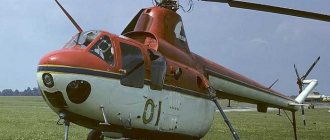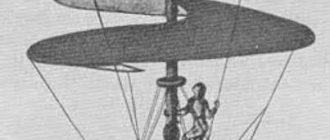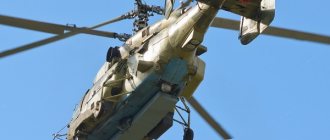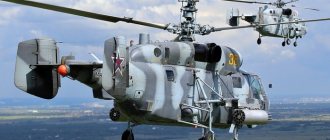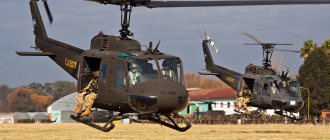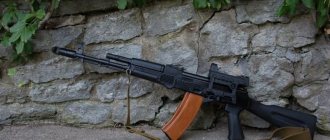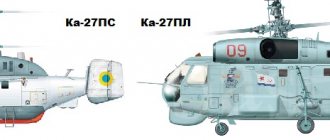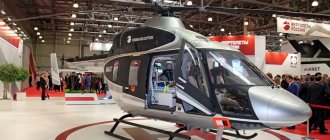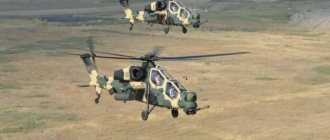| Mi-8AMT/Mi-171 | |
| Type | transport, civil, military transport helicopter |
| Developer | OKB Mil |
| Manufacturer | Ulan-Ude Aviation Plant |
| First flight | 1991 |
| Start of operation | 1992 |
| Units produced | no less than 265 copies. |
| Basic model | Mi-8 (Mi-17) |
| Media files on Wikimedia Commons | |
Mi-171
is a Soviet/Russian civil transport helicopter developed by the Mil Design Bureau, a modification of the Mi-8 (Mi-17) helicopter - Mi-8AMT (the export version is called Mi-171E).
Military modification of the Mi-8AMTSh helicopter ( Mi-171SH
, “Ш” - assault) was adopted for service in 2009[1].
Production
Helicopters of the Mi-8/17 type are produced at the Ulan-Ude Aviation Plant and the Kazan Helicopter Plant. As of 2014, more than 12 thousand of these machines were produced, which is a record figure in the world among twin-engine helicopters. They have been delivered to more than 100 countries around the world, their total flight time is about 100 million hours.
The following civilian models of the Mi-8/17[2] type are currently produced: Mi-8AMT
,
Mi-8MTV-1
,
Mi-171
,
Mi-171A1
and
Mi-172
.
Modifications
| Model name | Brief characteristics, differences |
| Mi-8AMTSh (export name - Mi-171Sh) | Military transport version of the Mi-8AMT (Mi-171) helicopter. Purpose: transportation and operational landing of up to 16 paratroopers, transportation of up to 12 wounded on stretchers accompanied by medical personnel, transportation of cargo up to 4000 kg in the cargo compartment, transportation of cargo up to 4000 kg on an external sling, highly effective destruction of enemy personnel, armored vehicles, surface targets, structures , fortified firing points and other moving and stationary targets, fire support for landing forces, escorting military convoys, CSAR (combat search and rescue), reconnaissance operations, patrolling, civil operations (search and rescue operations, fire fighting, and so on). |
| Mi-8AMTSH-V | An upgraded version of the Mi-8AMTSh military transport helicopter with new Klimov VK-2500-03 gas turbine engines, a more powerful TA-14 auxiliary power unit and an updated avionics set[3]. |
| Mi-8AMTSH-VA | Military transport helicopter for operation in difficult weather conditions of the Arctic zone and the Far North. It is developed taking into account the specifics of use in conditions of low temperatures, limited visibility during flights, including during the polar night[4] The purchase price of the Mi-8AMTSh for government orders increased from 200 million rubles in 2010[5] to 250 million rubles in 2012 year[6]. |
| Mi-171A1 | modification of the Mi-8AMT helicopter meets the US FAR-29 rotorcraft airworthiness standards. Operated by Brazilian Airlines. It features a fuel system without a supply tank, fuel tanks with intra-tank communications, fireproof steel hoods, two-chamber KAU-80 boosters and improved fire protection. |
| Mi-171A2 | Previously known as Mi-171M. Developed on the basis of the Mi-171A. The vehicle will have an improved power plant and transmission, an improved 2×GTE Klimov VK-2500PS-03 engine, a new load-bearing system, an upgraded avionics system, improved flight technical and operational characteristics, a new operation and maintenance system. Its maximum speed has increased to 280 km /h, but the dynamic ceiling remained the same. It will feature reduced maintenance costs, carry loads of up to 5 tons on an external sling, fly at ambient temperatures from −50 °C to +50 °C, and fly at higher permissible crosswind speeds. The flight range with main fuel tanks has been increased to 800 km. On January 23, 2012, the Mil Design Bureau began assembling the first prototype of the Mi-171A2[7]. In February 2012, the helicopter was presented at the HeliExpo-2012 exhibition in the USA[8]. On May 24, 2022, the Russian Helicopters holding company, during the International Exhibition of the Helicopter Industry HeliRussia-2018 (Moscow), handed over the first production Mi-171A2 helicopter produced by the Ulan-Ude Aviation Plant[9], which began commercial operation of this type on February 12, 2022. As of February 12, 2022, eight Mi-171A2 helicopters have been produced[10]. |
| Mi-171A3 | The modification of the helicopter complies with IOGP (International Association of Oil and Gas Producers[en]) standards and meets increased requirements for ensuring flight safety over the water surface[11]. |
“Made with us” and on Yandex.Zen
Mikhail Leontyevich Mil drew beautifully. It was said about his helicopters that they were born more in the artist’s studio than at the drawing board. Before starting work on a new helicopter, he sketched it, painted it and said: “This is the kind of car I will have!” In our time, Mikhail Leontievich would be called a “helicopter couturier.” Look at the drawing from his workbook for yourself. Do you recognize? This is the same Eight. In a few months, this sketch will turn into working drawings, become covered with metal and rise into the sky.Mi-8 is a unique helicopter. Created in the distant 60s of the last century, it has gone through fire and water, it has been modernized several times, but it has still retained its unique appearance. The machine is still in great demand, it is constantly being improved and is supplied all over the world. Just imagine what design development potential was laid down by its creators. The shape and contours of the helicopter are extremely harmonious, elegant and look modern decades after its creation.
Interesting Facts
The first modification of the Mi-8 (then still V-8) had only one AI-24 V engine, which was “taken” from the Mi-6, and a 4-bladed main rotor borrowed from the piston Mi-4. The first "eight" had square cabin windows, and instead of sliding blisters in the cockpit there were doors. Later, square windows gave way to round portholes and remained only on the passenger version of the helicopter. Photo B-8 Prototype In 1961, the first Mi-8 successfully passed factory tests and was ready for transfer to state tests. But Mil, shocking his entourage, said: “We were mistaken. It was necessary to make a twin-engine helicopter. We will start a new design.” The next “eight” (B-8A) already had 2 TV2-117 engines and took off just a year after the first modification took off. The use of 2 engines significantly increased the operational reliability and economic efficiency of the rotorcraft. In the event of failure of one engine, the helicopter could safely continue flying on one, which significantly reduced operational risks.
Mi-8 ordered by civilians
At that time, the main customer throughout the world, and therefore the trendsetter of helicopter fashion, was the army. But the Mi-8, which logically had to replace the military Mi-4, was developed on the instructions of the Ministry of Civil Aviation, which imposed its own fairly stringent operational requirements on the helicopter. The result was a reliable and economical vehicle that quickly found its place in the country's civilian life. Since 1965, the helicopter has been mass-produced. The military at that time continued to fly the piston Mi-4, and at that time there were already several helicopter divisions. Well, at first they didn’t believe in this car, but in vain.
In 1965, the helicopter achieved success. At the international air show in Le Bourget, the Mi-8 became famous. The eight were fielded together with the heavyweights Mi-6 and Mi-10. Mil KB helicopters created a sensation among specialists. Moreover, they surprised not only with their aerial records, but also with the manufacturability of their design. For example, such a “trifle” as vibration was then a real problem with helicopter aviation. In those years, the voice of a helicopter pilot on air could be easily recognized. It was intermittent with vibration. The Milevians found a solution to this problem, and our pilots spoke smoothly and without straining, which aroused the envy of their competitors.
After the Le Bourget air show, the USSR military command finally appreciated the merits of the Mi-8. It began to be used as a landing, transport, medical helicopter, flying command post, mine layer, jammer, and fire support helicopter. In total, hundreds of versions and modifications of this machine were produced. As you understand, listing them all is not only pointless, but also merciless. The most popular modification was the Mi-8T. The letter "T" stands for transport. By the way, these helicopters still fly, for example, in aviation.
Trick question: How many engines are on a helicopter?
The Mi-8T was equipped with TV2-117 engines, which were started using electric starters installed on them. There were exactly two of them. Starting from the modification of the Mi-8MT helicopter (modernized transport) to our time, not two, but three engines are installed. The third engine is the starting engine. It fires two main engines. The Mi-8MT modifications were equipped with more powerful TV3-117. To start this engine, an air turbo starter is used, which takes energy (compressed air) from a small auxiliary gas turbine engine AI-9 V. So it turns out that the helicopter has three engines.
How to externally distinguish Mi-8T and Mi-8MT?
Due to the replacement of TV2-117 engines with TV3-117, visual differences appeared between the T and MT modifications.
The first and most noticeable thing is that the tail rotor on the Mi-8T is installed on the right side in the direction of travel, on the Mi-8MT - on the left. Moving the tail rotor changed the direction of its rotation and thereby increased efficiency. The result was an increase in the directional control reserve (pedal range) and a general increase in power.
Secondly, due to the AI-9 V auxiliary engine, the cowlings on the Mi-8MT are longer than on the T and on the left there is a small nozzle of the AI-9 V engine.
Third, standardly installed dust protection devices for engines on the Mi-8MT (sort of “mushrooms” on the engine inlet devices). Their use on the Mi-8T was difficult, since they consumed up to 6% of the already low power of the TV2-117 engines.
Fourth, due to the increased payload capacity, the Mi-8MT is equipped with three-point beam holders for weapons as standard. The Mi-8T has two hardpoints on each side.
Who is there more in the world?
The G8 is the most popular medium helicopter in the world. In terms of the total number of vehicles produced—more than twelve thousand—the Mi-8 helicopter has no analogues among machines of its class. In this field, it is outperformed by the famous Sikorsky with its S-61 and UH-60 Black Hawk with all modifications combined, and by the cool Boeing in its series of helicopters from the Boeing Vertol CH-46 Sea Knight to the Boeing CH-47 Chinook. In terms of the number of vehicles produced, the Mi-8 is second only to the lighter American Huey, the Bell UH-1 Iroquois. But the Iroquois is already outdated forever, and the design groundwork for the “Black Hawk” that replaced it is already close to zero, and this despite the fact that it is eleven years younger than the Mi-8. The legendary “Eight” has not yet exhausted its development potential. In terms of its prevalence in the world, the Mi-8 helicopter has no equal; there is practically no country in which the “flying truck” is not operated. By the way, America is no exception here; it was the operator of the Mi-8.
Severe Russian
A lot has been said about our Eight, but I would like to especially highlight one of its qualities. None of its foreign competitors have this - reliability and ease of operation. It seems like a small thing, but look at the harsh experience of Afghanistan. There were our Mi-8s and American Black Hawks with Chinooks. We flew in the same area from the same airfields. In a word, “they swallowed the same dust.”
The service of Western cars was much better. It's not because we save on it and they don't. This is because their turntables are far more “gentle.” You can’t just tie them to a tank during a dust storm so that they don’t get blown away by the wind, and you can’t just leave them outside - sand can scratch the glass and ruin the paint, and temperature changes can upset the delicate electronics. Our helicopter can safely stand in the open air, and is not afraid of wind, sand and cold. Seriously, the quality of a helicopter such as the ability to operate autonomously without a hangar, especially in harsh climatic conditions, may be more important than brand new computer joysticks in the cockpit of a high-tech rotorcraft that, alas, cannot start in the cold.
When landing airplanes and helicopters on unequipped sites, in the northern territories of Alaska and Canada, the rules of the Air Code prohibit turning off engines during parking, no matter how long it lasts. They may not start again. The Arctic, like the entire globe, has been declared a “sphere of strategic interests of the United States.” As part of these interests, the US Department of Defense plans to reconstruct a fleet of light aircraft and helicopters that will be able to land on unequipped sites and ice floes. They will be equipped with modernized or newly designed engines that will be easy to start in Arctic conditions. But for now these are words. In the future, and it is not clear in what immediate future. And we already have one and it’s already flying, especially for ultra-low temperatures.
Conqueror of the North
Meet the Mi-8AMTSH-VA, a military transport helicopter specially designed for the harsh conditions of the Arctic. It can independently start the engines when deployed autonomously and without a hangar. It seems like nothing special; who among the helicopters can’t do this? Only the temperature can reach minus 60 Celsius. Now yes. Nobody can do that. The helicopter is equipped not only with special Arctic thermal insulation and a powerful heating system, but also with equipment for heating rations and water.
Flying in the Arctic is difficult. There are weak and disappearing satellite signals. GPS, unlike GLONAS, works very poorly there. This is because the orbits of GPS satellites have a low inclination and therefore the signal strength is low. GLONAS was developed taking into account high-quality work on our territory, and we are a northern country, therefore our system’s signal reception at northern latitudes is more stable. Add to this unstable radio communications, polar night, and virtually directionless terrain. Therefore, the Mi-8AMTSH-VA is equipped with new flight navigation and radio communication equipment, which allows automatic flight along a route with access to a given point. New Russian radio-electronic equipment determines the location of the vehicle even in the absence of satellite signals, provides complete weather information, and allows the helicopter to be safely operated at night, including in polar night conditions. The helicopter is equipped with new Russian VK-2500 engines produced by the St. Petersburg Klimov enterprise. 2700 horses in emergency mode allow the car to climb with one failed engine. The helicopter can cover 1,400 kilometers and stay in the air for more than 7 hours. What do you think of this extreme version of the magnificent eight? Something like this simply does not exist in the world.
The Magnificent Eight are still in action
In Russia, the largest operator of Mi-8 helicopters is aviation. It is also the largest helicopter company in the world in terms of fleet size and capacity. The airline's fleet includes more than 264 Mi-8 helicopters of various modifications, including 163 Mi-8T. The geography of commercial operation of this aircraft fleet is extensive, but the main work takes place in Siberia, the North and the Far East of our country. The places are not the most affectionate on the geographical map. Eights, including those very first T-shki, serve oil and gas workers, geologists and rescuers. And this is done in very harsh climatic conditions.
On a personal note, I would like to say that the Mi-8 is not just a famous helicopter - it is a best-selling rotorcraft, it is one of the symbols of our country.
Author: Dmitry Drozdenko Photo: Russian Helicopters, Russian Ministry of Defense
Operators
Mi-171 helicopter of the Special State Security Service of Azerbaijan
Military
- Angola - 8 Mi-171Sh, as of 2016[12]
- Argentina - 2 Mi-171E, as of 2016[13]
- Armenia - 4 Mi-171s ordered (details awaited), as of January 2022.
- Bangladesh - 2 Mi-171Sh, as of 2016[14] A total of 6 Mi-171Sh and 1 Mi-171E were ordered under the 2015 contract[15]
- Vietnam - three Mi-171, as of 2016[16]
- Ghana - 4 Mi-171Sh, as of 2016[17]
- Iran - 25 Mi-171, as of 2016[18]
- Iraq - a number of Mi-171Sh, as of 2016[19]
- Kazakhstan - three Mi-171, as of 2016[20],[21]
- Kenya - 2 Mi-171, as of 2016[22]
- China - more than 144 Mi-171, as of 2016[23]
- Mongolia - 2 Mi-171, as of 2016[24]
- Nicaragua - 2 Mi-171E, as of 2016[25]
- Nigeria - more than six units ordered[26]
- Pakistan - 4 Mi-171 and 4 Mi-171Sh, as of 2016[27]
- Peru - 11 Mi-171Sh, as of 2016[28] A total of 56 Mi-171Sh were ordered according to the 2013 contact, deliveries began in 2014[29], deliveries were completed at the beginning of 2016[30]
- Senegal - 2 Mi-171Sh, as of 2016[31]
- Sudan - 2 Mi-171, as of 2016[32]
- Philippines - 4 Mi-171Sh, as of 2016[33]
- Croatia - 10 Mi-171Sh, as of 2016[34]
- Chad - 2 Mi-171, as of 2016[35]
- Czech Republic - 16 Mi-171Sh, as of 2016[36]
- Sri Lanka - 4 Mi-171Sh, as of 2016[37]
- Ecuador - 2 Mi-171E, as of 2016[38]
Accidents and disasters
- January 9, 2009
- Mi-171 crash near Vorkuta On December 19, 2009, a Mi-171 (tail number RA-22468) of the Ukhta branch of Gazpromavia Airlines LLC, carrying 22 passengers and three crew members, was flying on the route Bovanenkovo - Vorkuta. The aircraft made an emergency landing in the tundra 700 m from the Vorkutinskaya mine, approximately 4.5 km short of Vorkuta airport. During a hard landing of the helicopter, one of the passengers received serious injuries, from which he later died. In addition, serious harm was caused to the health of another passenger[39][40].
- A Mi-171 helicopter of the Azerbaijani Air Force fell into the sea not far from the coast near the city of Baku. All three crew members were killed.[41]
- On July 7, 2014, a Vietnamese Air Force Mi-17 helicopter crashed in a suburb of Hanoi. There were 21 people on board. Of these, 16 were Vietnamese Air Force paratroopers, two instructors and three crew members. 16 people died[42].
- On July 22, 2014, a Mi-171 military helicopter crashed in the Chinese province of Sichuan. 5 people were injured[43].
- On March 14, 2015, a military helicopter carrying a sick baby from the Raska region in the south of the country crashed in Serbia for hospitalization in Belgrade. The Mi-171 helicopter crashed near Belgrade Nikola Tesla Airport. There were also four crew members and two medical workers on board. According to a preliminary version, the cause could have been bad weather conditions[44].
- In November 2015, during NATO exercise Trident Juncture, a Mi-171Sh from the Czech Air Force fell from a height of 10 meters and turned over on its side. The co-pilot and four paratroopers were slightly injured. According to the Czech Minister of Defense Martin Stropnicki, there was no technical malfunction with the helicopter[45].
- On October 19, 2016, a Mi-171 military helicopter crashed in the Fergana region. 9 people died (three crew members and 6 military passengers)[46]. According to a preliminary version, the cause could have been bad weather conditions.
- On August 3, 2022, the fifth prototype of the Mi-171A2 helicopter made an unsuccessful landing during a training flight on Elbrus[47]. The helicopter lay on its side and was damaged; there were no casualties as a result of the hard landing[48].
Performance characteristics
Data source: Corner of the Sky
Specifications
- Crew: 3 people
- Passenger capacity: 26 people
- Load capacity: 4000 kg
- Length: 18.17
- Main rotor diameter: 21.29 m
- Height: 5.65
- Empty weight: 6800
- Normal take-off weight: 11100 kg
- Maximum take-off weight: 12000 kg
- Powerplant: 2 × TV3-117 (VK-2500)
- Engine power: 2 × 1641 kW (2014)
Flight characteristics
- Maximum speed: 250 km/h
- Cruising speed: 225 km/h
- Practical range: 610 km
- Service ceiling: 5000 m
- Static ceiling: 3900 m
, ECN SHYYAONPRMNE NANGMYUVEMHE lH-171b.
bePRNKERSH lH-8Yulr (SHYYAONPRMNE NANGMYUVEMHE lH-171b) OPEDMYUGMYUVEMSH DK RPYUMYAONPRHPNBYKH KHVMNTSN YANYARYUBYU, YU RUYFE PUGKHVMSHU TsPSGNB BMSRPKH YUAKHMSH X MU BMEMEI OND BEYAYE. NMH LNTsSR OPHLEMREYA, B RNL VHYAKE, KH DK OPNBEDEMKH YAOYUYUREKEMSHU NOEPYUZHKHI, YU RUYFE MEYARKH MU YAAEE PUGKKHVMNE BNNPSPHEMHE.
MENTHZHHYUKEMNE MYUHLEMNBYUMHE DUMMNI LYUHMSH "REPLHMYURNP", OND SCHRHL NANGMYUVEMHEL BEPRNKER DELNMYARPHPNBUKYA B 1999 TsNDS B BEKKHYNAPHRYUMHH MU YUBHYUYUKNME TYUPMANPN. mu BNNPSPHEMHE bbya pNYAYAHH BEPRNKER ASHK OPKHMIR B 2009 TsNDS.
dYUMMSHI BEPRNKER YANUPYUMHK UNPNNYKHE DEYYUMMRN-BSHIYUDNVMSHE BNGLNFMNYARKH. NOSHR YANBPELEMMSHU KNYYUKEMSHU YNMTKHYRNB KH BNIM ONYUGSHBUER, VRN S BEPRNKERYU NVEME LYUKN BPELEMKH, BYAETSN MEYAINKEIN DEYAYRYINB YAYSMMD MU BSHYYUDS DEYUMRYU, PYYAYYUGSHBYU ER KERVKHY OEPBNTSN YKYUYAYU LUINP yuKEYYYUMDP aYUPYASINB. ONYAKE SCHRNTSN LYUHMS LNTsSR KETSIN YAAKHRE, DUFE, MEYALNRP MU NVEME UNPNEE APNMHPNBYUMKHE. dKЪ RNCN VRNASH SLEMEHRE BPEL BSHYYUDYKH DEYUMRYU, BEPRNKERSH lH-8yulr ONKSVKHKH YADBHFMSHE DBEPKH, YNRNPSHE NRYPSHBUCHRYA I DBSU ANPRNB, YU RUYFE YUBRNLYURKHVEYAYSCH PU LOS, YNRNPYU GYULEMHKYU YANANI LEUUMHVEYAYKHE YARBNPYKH. tsKYUBMSHL FE NRKHVHEL LYUHMSH YARYUKYU BNGLNFMNYARE YANBEPIURE MNVMSHE ONKERSH. ONKERSH B NVYUU MNVMNTSN BKhDEMHJ DK PNYAHIYAYKHU BEPRNKERVKHYNB BEYE DNYARYURNVMN MNBUYU. hLEMMN HY HYAONKEGNBUMHE ONGBNKYER NAEYAOEVHRE MNVMNE OPHLEMEMHE BEPRNKERYU lH-8yulr.
oPH MENAUNDHLNYARKH MU BEPRNKER LNFMN SYARYUMNBHRE YNLOKEYA SOPYUBKELNTSN BNNPSFEMH, YNRNPSHI ASDER YUMYUKNTSKHVEM BEPRNKERS lH-24. oNLHLN SCHRNTSN BEPRNKER ONKSVHK SYAKHKEMMSCH APNMEGYUYHRS (NAKETSVEMMYU LERYUKKNYEPYULKHVEYAYU APNM), YU RUYFE MNBSC YUBKHNMHYS. MNBSHY YNLOKEYA YUBHNMHYH BEPRNKERYU ONLHLN OPNVETSN BYKCHVUER B YEAA LERENPYUDYUP, NVYH MNVMNTSN BHDEMKH OKHKNRYU, YuOOYUPYURSPS YAOSRMKHYNBNI MYUBKHTSYUZHHH X KHMTPYYUPYYAMSCCH Yu OOYUPURSPS. YNLOKEYA NANPNMSH BEPRNKERYU lH-8yulr BYKCHVUER B YAYEAYAKHYARELS NRYARPEKYU KNBSYYUYAN-2B KH SHYPYUMMN-BSHUKNOMSHE SYARPNIYARBU.
bNNPSFEMKHE BEPRNKERYU LNFER PYUGLEYYUREYAYA MU 4-6 AYUKNVMSHU DEPFYUREKU, PUYAONKNFEMMSHU ON ANYUL TCHGEKKFYU. ьRSPLNBYU BEPYAKH BEPRNKERYU HLEER OPNRKHBNRYUMINBSHI YNLOKEYA OND MYUGBYUMHEL "jRSPL-b", DBU SMKHTKHZHPNBUMMSHU OSIEVMSHU INMREIMEPYU soy-23-250, BNYAELE SOPIUBKEL SHU PUYER RHOYU 9l120 X 9l114, OSYS ts-23k, YU RUYFE VERSHPE AKNYU a8b20-yu, KHLECHYKHE B YNLOKEIRE MESOPYUBKELSHE PUYERSH YKYYYYYU I-8. RUYFE OPH MENAUNDHLNYARKH LNFMN SYARYUMNBHRE YNLOKEYA SOPYUBKELNTSN PUYERMNTSN BNNPSFEMHЪ OND MUGBYUMHEL “khTsKYU-b”, NRMNYAYEEEYY YKYUYAAS “BNGDSU-BNGDSU”.
b BEPRNKERE B MNYANBNI X YNPLNBNI SYARYUMNBYUU PYYAONKNFEMSH ONDBHFMSHE OSKELERSH oir, KHLECHYKHE YUKHAP 7.62 LL. yPNLE RNCN, B OPNELE OPNUNDMNI DBEPH KH B ANYNBSHU NYMYU YASDMYU MU EYARKH UBNPMEBSHU SYARYUMNBYUU LNFMN PUGLEYARKHRE NPSFHE DEYUMRMKHYNB. ON ANYUL TCHGEKFYU YASDMYU KHLECHRYA VERSHPE HKKH EYARE AYUKNVMSHU DEPFYUREK, MU YNRNPSHU LNFMN SYARYUMNBKHRE MU ONDBEYAYE KHLECHYEEYYUBKHYUZHNMMNI BNNPSFEMKHE.
bePRNKER lH-8yulr NRKHVYUERYA MYUKHVHEL DNONKMKHREKEMNTSN APNMHPNBYUMKH, YNRNPNE GYUYKHYUER VKEMNB SHCHYHOYUFYU. aPNMEI ASHKKH OPKHYPSHRSH DMKHYE KH OEPEDMЪ VYUARE OHKNRYAYNI YUAKHMSH. hLEERYA APNMEOKHRYU LEFDS YUAHMNI X TsPSGNBSHL NRYAYNL, RUYFE APNMEOKHRYU SYARYUMNBKEMYU B TsPSGNBNL NRYAYE OND LEYARNL YARPEKYU. schYHOYUF BEPRNKERYU YANYARNHR XG 3-U VEKNBEY: YNLYUMDHPYU SHYHOYUFYU, KERVHYU-URSPLYUMYU H ANPRNBNTSN REUMHYU. OPH SHCHBUYYUZHHH ONYARPYUDYUBKHU X OPNBEDEEMKHH PUGKHVMSHU YAOYUYUREKEMSHU PYUANR MU ANPRS BEPRNKERYU LNTsSR OPHYASRYARBNBURE LEDKHZHMYAYKHI PUANRMKHY(X), YAOYUYUREKE(X).
dK PEYEMH BYAEU OEPEVHYAKEMMSHU GYUDYUV BEPRNKER lH-8yulr LNFER HYAONKEGNBUREYA B DEYUMRMNL, RPYUMYAONPRMNL, ANEBNL HKKH B YAYUMHRYUPMNL BYUPHYUMRYU:
- DEYYUMRMSHI BYUPHYUMR - OPEDMYUGMYUVEM DK RPYUMYAONPRHPNBYKH DEYYUMRMKHYNB YAN YAMYUPFEMHEL (LYUYYAHLYUKEMN 20 VEKNBEY, I SYARYUMNBKEMMSHLH DNONKMHREKEMSHHLH DEYUMRMSHLH YAHDEMHILKH - 34 VEKNBEYU).
- RPYUMYAONPRMSHI BYUPHYUMR:
- AEG SYARYUMNBYKH DNONKMHREKEMSHU RNOKHBMSHU AYUNB (DK OEPEBNGYKH B TsPSGNBNI YUAHME TsPSGNB LYuYAYANI DN 4000 YTS);
I NDMHL DNONKMHREKEMSHL RNOKHBMSHHL AYYNL;
- I DBSL DNONKMHREKEMSHHLH RNOXBMSHHLH AYYYULH;
- DK OEPEBNGYKH TsPSGNB LYUYAYANI DN 4000 YTS MU BMEMEI ONDBEYAYE; D) DK RPYUMYAONPRHPNBYKH YPSOMNTSUAYUPHRMSHU TsPSGNB, PYYAONKNFEMMSHU BMSRPKH TsPSGNBNI YUAHMSH I NRYPSHRNI PYULONI.
- ANEBNI BYUPHYUMR I SYARYUMNBKEMMSHL BNNPSFEMHEL:
- I AKNYULH a8b-20yu;
YAN YARPEKINBN-OSIEVMSHL BNNPSFEMHEL, HYAONKEGSCHRYA YNMREIMEPSH soy-23-250;
- I AM ANLAYUPDHPNBNVMSHL BNNPSPHEMHEL.
- YAYUMHRYUPMSHI BYUPHYUMR:
- I PUMEMSHLH MY MNYAHKYUU (LYUYAHLSL 12 VEKNBEY);
YNLAKHMHPNBYUMMSHI BYUPHYUMR - YAHDVKHE PYUMEMSHE X PYUMEMSHE MY MNYAHKYUU (LYUYAHLYUKEMN 20 VEKNBEY: 17 YAHDVKHU X RPNE MU MNYAHKYUU);
- I NDMHL DNONKMHREKEMSHL RNOKHBMSHL AYUINL X PYUMEMSHLH (LYUYAHLYUKEMN 15 YAHDVKHU PYUMEMSHU).
- OPETSNMNVMSHI BYUPHYUMR: I DBSL DNONKMHREKEMSHLH RNOKHBMSHLH AYUYULH, YNRNPSHE SYARYUMYUBKHBUCHRYA B TsPSGNBNI YUAHME.
b ZHEKU SLEMEYEMKH GYUBKHYAHLNYARKH NR KHMNYARPUMMSHU ONYARYUBYKHINB BYAE BEPRNKERSH lH-8Yulr-b ASHKH NYAMYUYEMSH YANBPELEMMSHL NANPSDNBYUMHEL NREVEYARBEMMNTSN OPNKHGBNDYARBU. mu BEPRNKERE ONЪBKHKHYAE ANKEE LNYMSHE DBKHTSUREKKH by-2500-03, YNRNPSHE BSHOSYAYUCHRYA YNLOYUMKHEI "YKHLNB" (BUNDHR B NAZEDKHMEMMSCH DBKHTSYUREKEMSCH YNPONPYUZHCH). dBKHTSYUREKH by-2500-03 ЪБКЪЧРЯЪ DUKEMEYHHL PUGBHRHEL YAELEIYARBU DBKHTSYUREKEI rbg-117 KH NAKYUDYUCHR SKSVIEMMSHLH UYUPYYREPHYARKHYULH, VRN ONGBNKYER GMYUVHREKEMN SBEKKHVHRE MUDEFMNYARE KH AEGNOYUYAMNYARE ANEBNTSN HYAONKEGNBYUMKH BEPRNKERYU KH B ZHEKNL cru LYUHMSH. oNLHLN SCHRNTSN BSHPNYAKHI PEYASPYA NREVEYARBEMMSHU DBHTSYUREKEY DNKFEM AKYUTSNOPHYRMSHL NAPYUGNL YAYUGYUREYAJ MU YARNHLNYARH SHYAOXYURYUZHHH lH-8Yulr-b B BNIYAYUU.
dKЪ BSHONKMEMHYUV lHMNANNPNMSH pt B SYAKNBKHU yPYRKHYH UNKDKHMC "bePRNKERSH PNYAYAHH" YANGDUK YAOEZHKHYUKHGHPNBYUMMSHI BEPRNKER lH-8yulr-by, YNRNPSHI ASHK YANGDYUM MU AYUGE ONYAKEDMEI LNDKHTHYUZHHH BNEMMN-RPYUMYAONPRMNTSN BEPRNKERYU lH-8yulr-b, YNRNPYU NRKHVYUKYUYAE SYARYUMNBYNI MNBSHU TSYUGNRSPAKHMMSHU DBKHTSUREKEY "YKHLNBU" by- 2500-03, YU RUYFE ANKEE LNYMNI BYAONLNTSYUREKEMNI YAHKNBNI SYARYUMNBYNI (byas) ryu-14 X NAMNBKEMMSHL MYUANPNL YUBKHNMKHYKH.
eYE NDMHL MUOPYUBKEMHEL LNDEPMHGYUZHHH BEPRNKERYU YARUKYU GYULEMYU YAHKNBNI SYARYUMNBYH yuh-9b, YNRNPYU OPNKHGBNDHKYUYAE MU SYYYUHME, MU NREVEYARBEMMSC LNDEKE ryu-14, YNRNPYU BSHOSYAYUERYA MOO "YUSHPNYAKHKYU". bYaONLNTsYUREKEMY YAKHKNBU SARYUMNBYU ryu-14 NRKHVYUERYA ANKEYEI LNYMNYARECH, YU RUYFE SBEKHVEMMSHL BPELEMEL PUANRSH B TSEMEPYURNPMNL PEFHLE. ryu-14 NAKYUDUER KSVIHLH ONYUGYUREKLH BSHYANRMNYARH GYUOSYAYU (6000 LERPNB OPNRHB 4000 LERPNB S OPEDIYARBEMMKHYU). AKYUTSNDYUP SYARYUMNBYE MNBNI BIAONLNCYUREKEMNI SYARYUMNBYH BNGLNFMNYARH BKHMRNYPSHKNI LYUKHMSH OPH EE SHYYAOXYURYUZHKH B BSHYANYNTsNPMNI LEYARMNYARH X YUBRNMNLMNL AYUGHPNB YUMHH GMYUVHREKEMN BSHPNYAKH.
sYARYUMNBKEMMYU MU lH-8Yulr-b YAOSRMHYNBUYU MYUBKHTSYUZHNMMYU YAHYARELYU ala NREVEYARBEMMNTSN OPNKHGBNDYARBU LNFER PUANRYURE YUYYA GPS, RYUYHYA PNYYAHYAYNI YAHYARELNI tsknmyuyaya . YANBPELEMMSHI YNLOKEYA YAPEDYARB YABGH RUYFE NREVEYARBEMMNTSN OPNKHGBNDYARBU ONGBNKYER SHYHOYUFS ANEBNI LYUKHMSH ONKEGNBUREYYYUVEYARBEMMNI YABGECH B BKHPNYNL DHYUOYU GNME VUYARNR. dK AEGNOYUYAMNYARH ONKERNB KH SDNAYARBU SHYKHOYUFYU MU LYUHME ASHK YALNMRKHPNBYUM MNBSHI NREVEYARBEMMSHI LERENKNYURNP, KHLECHYKHI TSMYZHKHCH BSHBNDU RPEULEPMNTSN KHNAPUFEMHJ LERENPNK NTSKHVEYAYKHU NAPYUGNBYUMKHI KH NAZEYRNB. xMTNPLYUZHH I MYUBKHTSYUZHNMMNTSN NANPSDNBYUMH KH LERENKNYURNPYU, YNRNPYU ONBSHUER SDNAYARBN OKHKNRKHPNBYUMKH KH AEGNOYUMNYARE ONKERNB, BSHBNDKHRYAJU LMNTsNTSMYZHNMYU KEMSHI ANKENNI ZHTPNBNI DHYAOKEY B YUAHME OKHKNRNB.
dK ONBSHYEMKH ANEBNI FHBSVEYARKH LYUKHMSH KH SHCHYHOYUFYU BEPRNKER NYAMYUYUERYA YANBPELEMMMNI PNYAYAKHIYAYNI YEPYULNLLERYUKKHVEYAYNI APNMEI, NAKYUDYUCHYEI OH YAPYUBMEMHCH YAN YARYUKEMNI APN MEI ANKEYEI YARNIYNYARECH OPH LEMEYEL BEYAE. YAKHYARELSH GYUYHRSH KH BNNPSFEMKH, YANBPELEMMNE PNYYAKHIYAYNE PYUDKHNYABGMNE KH OHKNRYuFMN-MYUBKHTSYUZHNMMNE NANPSDNBYUMKHE, YU RUYFE LHPNYKHI MUANP DNONKMHREKEMNTSN NANPSDNBYUMKH ONGBNKKCHR BNEMMN-RPYUMYAONPRMNLS BEPRNKERS lH-8yulr-b NRBEVYURE BIAEL RPEANBYUMKHL YANBPELEMNYARKH.
1 YUBTSSYARYU 2011 Ts. Ya nyun “s-syug” ASHK GUYKCHVEM TSNYASDYUPYARBEMMSHY YNMRPUYR MU ONYARYUBYS DBSU BEPRNKERNB B MNBNI YNLOKEYRYUZHKH lH-8yulr-1 I ANPRNBSHL YNLOKEYANL NANP NMSh k370sch8 “bHREAYAY”.
YANTSKYuYAMN SYAKNBHJL YNMRPYURYU ONYARYUBKELSH BNGDSMSHE YASDU DNKFMSH YANNRBERYARBNBURE REUMHVEYAYHL SYAKBNHYL Y AYUGNBNI LNDHTHYUZHHH lH-8yulr rs-8yulr-2 004 X DNONKMHREKEMSHL RPEANBYUMHL, SRBEPFDEMMSHL mts bya Fri B KhChKE 2011 Ts. LNI AYUGNBNTSN YNLOKEYAYU NANPNMSH "bHRAYAY" » (KhGDEKHE k370sch8-6ab) X, SYARPNIYARBU BSHAPNYAYU KNFMSHU REOKNBSHU ZHEKEYI sb-26l I ANEINLOKEYRNL 192 OYURPNMYU YUKHAPIU 26 LL (LEYARHAYUKNVMNE) I OSKERNL SOPYUBKEMKH S KERVKHYU-URSPLYUMYU KH DNONKMHREKEMSHLH YMNOYULH S YNLYUMDKHPYU SHYHOYUFYU KH ANPRREUMKHYU BLEYARN URRMNTSN SYARPNIYARBU sb-26ya- 02. (asp) ONKERMNI KHMTNPLYUZHKH "rEYAR-1" (BLEYARN yaupoo-12d1l).
cru:
| lNDHTHYUZHH | lH-8yurl-b |
| dHYULERP TSKYUBMNTSN BKHMRYU, L | 21.29 |
| dHYULERP UBNYARNBNTSN BKHMRYU, L | 3.91 |
| dKHMYu,L | 18.22 |
| bSHYANRYU,L | 5.65 |
| I love it, JC | |
| OSYARNCN | 7260 |
| MNPLYUKEMYU BGKERMYU | 11100 |
| LYUYAHLYUKEMYU BGKERMYU | 13000 |
| bMSRPPEMMHE RNOXBN, JC | 1450 + NOZHHNMYUKEMN 1420 |
| RHO DBKHTSUREK | 2 tsrd by-2500-03 |
| lnymnyare, YbR | 2 U 2400 |
| LYUYAKHLYUKEMYU YAYNPNYARE, YL/V | 260 |
| yPEIYEPYAYU YAYNPNYARE, YL/V | 225 |
| oPUYRHVEYAYU DUKEMNYARE, YL | 1200 |
| DYUKEMNYARE DEIYARBKH, YL | 465 |
| oPUYIRKHVEYAYKHI ONRNNKNY, L | 6000 |
| YaRYURKHVEYAYKHI ONRNNKNY, L | 1900 |
| ShYKHOYUF, VEK | 2 |
| ONKEGMYU MYUTSPSGYU: | 34 YANKDURYU HKKH 12 MYAHKNYY I YANOPNBNFDYUCHIHLH XKH 4000 YTS TsPSGYU B YUAHME XKH 3000 YTS MU ONDBEYAYE |
| bNNPSPHEMHE: | DBYU 12.7-LL OSKELERYU H GYUDMKHI OSKELER oir aNEBYU MYUTSPSGYU - 1400 YTS MU 6 SGKYU ONDBEYAYH: 4 os sb-16-57 16U55-LL HKH sb-32-57 32U57-LL, HKH 4 250-YTs ANLASH, KHKH 6 ORSP " YURYUYU" HKH "URSPL", 4 joint ventures BNGDSU-BNGDSU "khTsKYU |
| bottom. KhMTNPLYUZHKH: |
| tNRNTsPYUTHH: | lH-8yurl (c) bEPRNKERSH PNYAYAHH |
| lH-8yurl (c) lHUYUHK lHGHYYUEB | |
| lH-8yurl (c) Kabuki | |
| lH-8yurl (c) bBVEYAKUB aYUAYUEBYAYKHI | |
| lH-8yurl | |
| lH-8yurl | |
| lH-8yurl-by |
| YaOHYANY HYARNVMKHYNB: |
| bNEMMNE NANGPEMHE. rPYUMYAONPRMN-jRSPLNBNI BEPRNA╦R lH-8yulr sKYUM-sSHMYAYKHI YUBKHYUZHNMMSHHI GYUBND. oPNDSYZHH. lH-171ь Oursarmy.ru. jRSPLNBNI BNEMMN-RPYUMYAONPRMSHI BEPRNKER lH-8yulr Bmpd. bePRNKERSH lH-8yulr-1 |
sTSNKNY MEAYU. 2018
Comparison of modern civil helicopters from Kamov and Mil Design Bureaus
| Ka-62 | Ka-32 | Mi-171/Mi-8AMT | Mi-38 | |
| Crew | 1-2 | 2 | 3 | 2 |
| Passenger capacity (persons) | 15 | 13 | 26 | 30 |
| Load capacity / external sling, kg | 2 200/2 500 | 5 000 | 4 000 | 5 000 |
| Maximum take-off weight, kg | 6 500/6800 | 11 000 | 12 000 | 15 600 |
| Power point | 2 × TVAD Turboméca Ardiden 3G | 2 × TV3-117VMA | 2 × TV3-117 (VK-2500) | 2 × TV7-117V |
| Engine power, l. With. | 2 × 1776 (in takeoff mode) | 2 × 2200 | 2 × 1641 kW | 2 × 2800 |
| Cruising speed, km/h | 290 | 240 | 225 | 260-280 |
| Practical/ferry range, km | 720 | 800 | 610 | 820/1350 |
| Static/Dynamic ceiling, m | 3200/6100 | 3500/6000 | 3900/5000 | 5250/6300 |
Design of the Mi-8 helicopter
The Mi-8 helicopter has a single-rotor design with a five-blade three-hinge main rotor and a three-blade tail rotor. The fuselage is framed and has a tail support to protect the tail rotor.
The landing gear is tricycle, non-retractable, with a self-orienting front strut that is fixed in flight.
The power plant consists of 2 gas turbine engines TVD TV2-117. From the engines to the shafts of the propellers and auxiliary mechanisms, power is transmitted through a three-stage main gearbox VR-8A. The fuel supply is located in 3 fuel tanks. It is possible to install 1-2 additional fuel tanks of 915 liters each in the cabin (in the cargo version).
The passenger Mi-8P differs from the transport Mi-8T by rectangular windows and the absence of a Doppler antenna for the DIV-1 ground speed and drift angle meter on the tail boom. Its interior has 28 soft passenger seats (as an option, there were models with 20, 24 and 26 seats). The Mi-8P can be used as an ambulance and transport, carrying cargo, including on an external sling.
In the transport version of the Mi-8T, semi-rigid folding seats for 24 passengers are installed in the helicopter cabin along the sides. Access to the salon is through the side sliding door. On the floor of the cabin there are mooring units and pulley rollers, and in the front part there is an electric winch. For loading large-sized plows and equipment, there is a cargo hatch with two doors in the rear. An electric winch boom is installed above the front door. There is an external cargo suspension system. The control is duplicated, with rigid and cable wiring, with hydraulic boosters.
Military versions of the Mi-8 can be equipped with a 7.62 mm or 12.7 mm machine gun in a mobile nose mount. Blocks of unguided projectiles, machine gun containers, or bombs with a caliber of 50-500 kg can be mounted on external double/triple side holders. Up to 6 anti-tank guided missiles can be placed on top of the holders on the guide rails. Machine guns and grenade launchers can be installed in the side openings of the troop compartment.
Notes
- The Ministry of Defense received the next batch of Mi-8AMTSH helicopters - WEAPONS OF RUSSIA - Armaments, military and special equipment (unspecified)
(inaccessible link). Access date: October 18, 2011. Archived June 16, 2011. - Mi-8/Mi-17
- Russian Helicopters will present the latest military helicopters at the Innovation Day of the Ministry of Defense (unspecified)
(August 4, 2014). - On August 4, 2014,
Russian Helicopters will present the latest military helicopters at the Innovation Day of the Ministry of Defense
(unspecified)
. - Delivery of Mi-8AMTSh and << Ansat-U >> - light multi-purpose helicopters. (economics.tech.itendersru.samoleti) : Newsletter : Subscribe.Ru
- Order Details
- Lenta.ru: Weapons: Assembly of a new version of the Mi-171 helicopter has begun
- Russian Helicopters presented the modernized Mi-171A2 helicopter in the USA
- Russian Helicopters handed over the first production Mi-171A2 to UTair - Helicopter Services // AviaPort.News
- Russian Helicopters validates the Mi-171A2 in Brazil (Russian). Air Transport Review (February 12, 2019). Date accessed: February 22, 2022.
- The Mi-171A3 offshore helicopter made its first flight (Russian). rostec.ru
. Rostec (December 16, 2021). - “Helicopters of Russia”: the Russian Federation transferred another four Mi-171Sh helicopters to Angola (unspecified)
. Access date: September 1, 2016. - The Military Balance 2016, p.377
- The Military Balance 2016, p.237
- The Military Balance 2016, p.299
- The Military Balance 2016, p.298
- The Military Balance 2016, p.449
- The Military Balance 2016, p.328
- The Military Balance 2016, p.332
- The Military Balance 2016, p.186
- The next batch of Mi-171Sh helicopters entered service with the Kazakhstan Air Force https://centrasia.org/newsA.php?st=1481094540
- The Military Balance 2016, p.452
- The Military Balance 2016, p.242,245
- The Military Balance 2016, p.275
- The Military Balance 2016, p.407
- The Military Balance 2016, p.480
- The Military Balance 2016, p.280
- The Military Balance 2016, p.410
- The Military Balance 2016, p.420
- RIA News.
Rosoboronexport: ready for negotiations with Brazil on Pantsirs.
The head of the Rosoboronexport delegation at the FIDAE-2016 exhibition in Chile, Sergei Ladygin, spoke in an interview with RIA Novosti about plans to promote Russian weapons to Latin American markets. (undefined)
.
Interview
. RIA Novosti (15:0028.03.2016 (updated: 17:42 19.04.2016)). - The Military Balance 2016, p.464
- The Military Balance 2016, p.471
- The Military Balance 2016, p.284
- The Military Balance 2016, p.84
- The Military Balance 2016, p.437
- The Military Balance 2016, p.88
- The Military Balance 2016, p.289
- The Military Balance 2016, p.396
- In Komi, the investigation into the emergency landing of a Mi-8 helicopter in the tundra in December 2009 has been completed (unspecified)
(inaccessible link). Access date: January 15, 2011. Archived February 1, 2014. - Report on the investigation of the accident with the Mi-171 helicopter RA-22468 Archived on September 27, 2011.
- Military helicopter crashed into the sea in Azerbaijan - Life.ru
- Military helicopter crashed in Vietnam, 16 people died - Zvezda TV Channel
- Military Helicopter Crashes in Sichuan Village
- A helicopter carrying doctors and an infant crashed in Serbia
- Ministry of Defense of the Czech Republic: the Mi-171SH did not have a technical malfunction (Russian), RIA Novosti
(20151106T1620+0300Z). Retrieved October 8, 2022. - The helicopter crashed in the Fergana region
- Mi-171 made a hard landing on Elbrus during a training flight, REN TV (April 3, 2018). Archived from the original on April 3, 2022. Retrieved April 3, 2022.
- A video of the Mi-171 hard landing on Elbrus has appeared (unspecified)
. NEWSru.com (April 7, 2019). Retrieved April 3, 2022. Archived April 3, 2022.
History of the creation of the Mi-8 helicopter
With the advent of the Mi-6 heavy helicopter, a new era in helicopter construction opened. However, a heavyweight was not needed everywhere and not always; a “medium” helicopter, like the Mi-4, was much more in demand, but the latter no longer met the requirements of the time.
On February 20, 1958, a Decree of the Council of Ministers of the USSR was issued ordering the development of a new helicopter to replace it, not with a piston engine, but with a gas turbine engine. The working name of the new helicopter was V-8, but it went down in history as the Mi-8 multi-purpose helicopter . The new vehicle was to be designed in two versions at once: the passenger Mi-8P and the transport Mi-8T.
G.V. Remezov (later V.A. Nikiforov) was appointed the lead designer for the V-8 (Mi-8), the general management of the project was carried out by deputy chief designer V.A. Kuznetsov.
Czech passenger helicopter Mi-8P.
In 1959, the preliminary design and full-scale model of the helicopter were approved, after which detailed design began. It immediately turned out that it was virtually impossible to use developments on the Mi-4 due to technical features. Specially for the Mi-8, OKB-117 designed a new engine with a power of 1250 hp. However, according to the decision of the general designer, there should have been two such engines on the helicopter.
The design of the Mi-8 in general was extremely advanced. Duralumin stamping of large parts, glue-welded joints, an automatic engine control system - all this was implemented for the first time specifically for him.
Since the idea was too revolutionary, the USSR Council of Ministers decided to build two versions of the B-8 at once: with one and with two engines.
The first prototype of the Mi-8 with one AI-24V engine and a four-bladed propeller from the Mi-4 first took to the air on June 24, 1961.
The second Mi-8 prototype with two TV2-117 engines and a new five-blade propeller took off on August 2, 1962. Joint state tests of both machines began in March 1963 and ended in favor of the twin-engine version of the helicopter.
The prototype of the V-8AP passenger helicopter was manufactured at plant No. 329 by May 1964, and then until March 1965, it underwent comprehensive testing.
Mi-8T helicopter. Pay attention to the windows - transport versions of the Mi-8 have round ones, while passenger ones have square ones.
Immediately upon their completion, the helicopter under the designation Mi-8P was put into serial production at the Kazan aircraft plant No. 387. By 1969, the Mi-8 had completely replaced the Mi-4 on the assembly line, and in 1970 the plant in Ulan-Ude began producing it. A transport version, the Mi-8T was adopted by the USSR Air Force in 1968.
In 1968, a group of workers at the Moscow Helicopter Plant were awarded the USSR State Prize for the creation of the Mi-8.
At the time of its introduction into service, the Mi-8 set 7 international records. In total, over the years of serial production from 1968 to 1996, about 8,200 Mi-8 helicopters were produced, which makes this helicopter the most popular in the world. At the same time, at least half of all produced machines are currently in good working order and work the same as 20 and 30 years ago.
2800 Mi-8s were exported. The list of its “habitats” includes 40 countries, including: Algeria, Angola, Afghanistan, Bangladesh, Bulgaria, Hungary, Vietnam, East Germany, Egypt, India, Iraq, Canada, China, North Korea, Cuba, the Netherlands, Nicaragua, Pakistan , Peru, Poland, Romania, Syria, Sudan, USA, Finland, Czechoslovakia, Ethiopia, Yugoslavia, Japan.
The helicopter is constantly being modernized and the current models are noticeably superior in performance to helicopters of earlier years of production.
Drawing diagram of the Mi-8 helicopter
